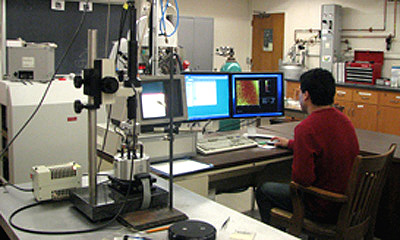Nanoscope Afm Manuals
- The AFM is quite complex and the startup procedure requires a specific order of turn on, so this document attempts to provide a simple guide to the process, especially for trained staff members. At the conclusion of this procedure, the tool should be ready for users to image samples. Turn on the NanoScope V controller using the power switch.
- NanoScope 8.15 Software: User Guide. User Manual Contents. The NanoScope Software 8.15 User Guide consists of the following main areas: Getting Started with NanoScope 8.15 Software.
We are please to announch the release of the latest version of NanoScope Analysis, Bruker's free offline data processing software. Download a copy by following the directions given here: NanoScope Analysis is a software package for analyzing SPM data (images, ramp data, HSDC, etc.) collected using Bruker SPMs. Current features and improvements include:. New!
Bruker Dimension Icon AFM. Quick User's Guide. GLA Contacts. Teddy Huang (zhuang@caltech.edu 404-697-3216). Noah Plymale (nplymale@caltech.edu 330-357-1204). 1) Read about “How to avoid breaking the. 3) Launch the NanoScope 8.15 software program. Select which experiment you want to.

G Binnig
Automation of image processing and analysis using “Run History” and browser improvements. New! Image Export allows export of images to BMP, TIFF, PNG and JPG with or without scale and color bar and either at a given dpi or with the original pixels. Works with “Run History” to allow many files to be exported at once. Creation of AVI movies using Image Export and Run History. New! Support for SIS files from Bruker NEOS microscopes.
New! Threshold indicator for Flatten and Plane-fit. Synchronized cursors and analyses: select multiple channels by control-clicking on the tabs. Subsequent analyses or cursors will be applied to all selected channels.


Color table editor: choose CommandsAdjust image color scale from the menu. Additional monitor size support now includes netbooks, laptops, multiple monitors, etc.
Parameter Icon Scanner FastScan Scanner X-Y scan range 90um x 90um typical, 85um minimum 35um x 35um typical, 30um minimum Z range 10um typical in imaging and force curve modes 9.5um minimum 3um Vertical noise floor 2mm/Sec max. Z tip max velocity - 12mm/Sec X-Y position noise (closed loop). Figure 7: Piezo change Figure 8: Clip open. No tip Figure 9: Tip change Figure 10: Clip open. Tip on Figure 11: Clip closed. Tip on.
Take the piezo Z with 2 fingers and install it on the scanning head. Switch on the vacuum and plug the connector Measurement routine. Login on the zone computer. Login on the AFM control computer. Place your wafer on the chuck and switch on the vacuum or stick your sample on the magnetic support and put it on the chuck. Double-click on the Nanoscope V815R2 icon to start the application.
Select the scanning mode from the menu (e.g. Figure 12: Scanning modes. If you have the message Stage initialize, then press yes;.
Select the menu setup and click on change probe (sub menu n°1, see Figure 6): - Select your tip from the list of tip proposed and check the beam size. The color of the beam size is red if the beam size on the scanning head is not correct. Proceed to the change of the tip (see the paragraph ) and then press OK - Focus the camera on the tip (sub menu n°2) - Align the beam on the tip with a double click on the tip (sub menu n°3) - Align the camera on the tip (sub menu n°4) - For tapping mode only: select your resonance frequency (sub menu n°5).
Go into R, click on Packages (at the top of the R console), then click on 'Install package(s) from local zip files', then find the zip file with arm from wherever you just saved it. Do the same thing to install each of the other packages you want to install. You have downloaded a zip of the source of a package. This is not the standard packaging of a package source nor is it a standard Windows binary (i.e., a built package distributed as a.zip, as from CRAN). The easiest thing for you to do is to install this package directly from Github using devtools. Zip package file. This document is written mostly because Installing R packages from a local file on Mac OS X is not too obvious. The windows section is just tagged to the beginning. Installling R packages on Windows. Select 'install packages(s) from local zip files', under the 'Packages' pull-down menu, as below: There is.